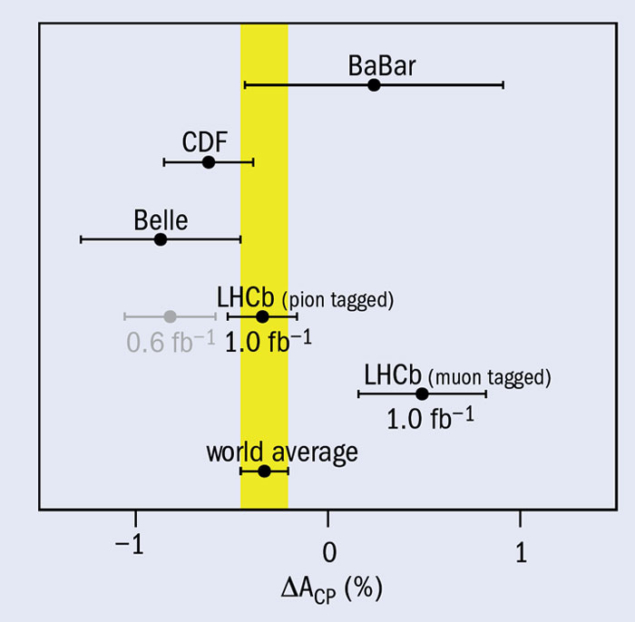Using two independent analyses, the LHCb collaboration has updated its measurement of ΔACP, the difference in CP violation in the decays D0→K+K– and D0→π+π–. This helps to cast light on the whether – and to what extent – CP violation occurs in interactions involving particles, such as the D0, that contain a charm quark.

The new results represent a significant improvement in the measurement of ΔACP, which has emerged as an important means to probe the charm sector. A previous measurement from LHCb was 3.5σ from zero and constituted the first evidence for CP violation in the charm sector (LHCb 2012). Subsequent results from the CDF and Belle collaborations, at Fermilab and KEK, respectively, further strengthened the evidence but not to the 5σ gold standard. Because the size of the effect was larger than expected, the result provoked a flurry of theoretical activity, including new physics models that could enhance such asymmetries and ideas for measurements that could elucidate the origin of the effect.
Both of the new measurements by LHCb use the full 2011 data set, corresponding to an integrated luminosity of 1.0 fb–1 of proton–proton collisions at 7 TeV in the centre of mass. The first uses the same “tagging” technique as all previous measurements, in which the initial flavour of the D meson (D0 or D–0) is inferred from the charge of the pion in the decay D*+→D0 π+. The second uses D mesons produced in semimuonic B decays, where the charge of the associated muon provides the tag. The two methods allow for useful cross-checks, in particular for biases that have different origins in the two analyses.
Compared with LHCb’s previous publication on ΔACP, the new pion-tagged analysis uses more data, fully reprocessed with improved alignment and calibration constants (LHCb 2013a). The most important change in the analysis procedure is that a vertex constraint has been applied to achieve a factor 2.5 better in background suppression. The result, ΔACP = (–0.34 ± 0.15 (stat.) ± 0.10 (syst.))%, is closer to zero than the previous measurement, which it supersedes. Detailed investigations reveal that the shift caused by each change in the analysis is consistent with a statistical fluctuation.
To add to the picture, the muon-tagged analysis also measures a value that is consistent with zero: ΔACP = (+0.49 ± 0.30 (stat.) ± 0.14 (syst.))% (LHCb 2013b). In both analyses, the control of systematic uncertainties around the per mille level is substantiated by numerous cross-checks. As the figure shows, the two new results are consistent with each other and with other results at the 2σ level but do not confirm the previous evidence of CP violation in the charm sector.
Theoretical work has shown that several well motivated models could induce large CP-violation effects in the charm sector. These new results constrain the parameter space of such models. Further updates to this and to related measurements will be needed to discover if – and at what level – nature distinguishes between charm and anticharm. The full data sample recorded by LHCb until the start of the long shutdown contains more than three times the number of charm decays analysed in these new analyses, so progress can be anticipated during the LHC long shutdown.
Further reading
LHCb collaboration 2012 Phys. Rev. Lett. 108 111602.
LHCb collaboration 2013a LHCb-CONF-2013-003.
LHCb collaboration 2013b LHCb-PAPER-2013-003, arXiv:1303.2614 [hep-ex].








